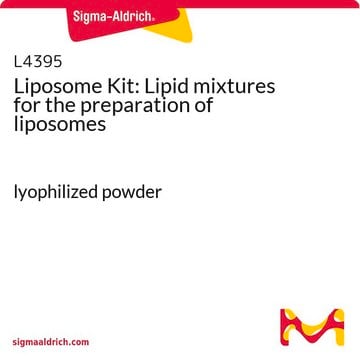LPC-610
Lyophilized Liposomes - Natural Phosphatidylcholine (PC) Lipid Extracts
Soy PC:Cholesterol (70:30 molar ratio)
Zaloguj sięWyświetlanie cen organizacyjnych i kontraktowych
About This Item
Kod UNSPSC:
12352211
NACRES:
NA.25
Polecane produkty
Postać
lyophilized powder
skład
Soy PC:Cholesterol (70:30 molar ratio)
kolor
white to off-white
średnia wielkość cząstek
100 nm
Szukasz podobnych produktów? Odwiedź Przewodnik dotyczący porównywania produktów
Opis ogólny
Lyophilized liposomes product series are freeze-dried liposomes with various types of lipids and wide range of zeta potentials and different properties. These products should be used by scientists who understand liposome formulation and have the proper equipment to check the size, separate non-encapsulated drugs and do the proper assays.Liposomes are extensively used to study the interaction of proteins, peptides and other molecules with the surface of a lipid membrane. One of the parameters that affects this interaction is the charge of the liposomal membrane. Liposomes are always made in aqueous environment and they are sized to the desired size in liquid state using various methods such as high-pressure extrusion through nano sized pore track etch membranes. In rare occasions, liposomes are freeze dried and proliposomes are formed in the presence of a lyoprotectant such as trehalose. Using a lyoprotectant is necessary in order to maintain the size of the liposomes after rehydration.
Natural Phosphatidylcholine (PC) liposomes are made from natural lipids extracted from egg yolk, soybean, or tissues such as brain, heart, and liver. The Natural PC liposomes are available with and without cholesterol. Adding 30% cholesterol makes the liposomes serum stable and is necessary when the liposomes are used in the presence of serum.
Soy phosphatidylcholine (PC) contains both saturated and unsaturated lipids, but has a larger percentage of unsaturated lipids compared to egg, brain, heart and liver extracted PCs. It is composed of: 14.9% 16:0 lipid, 3.7% 18:0 lipid, 11.4% 18:1 lipid, 63% 18:2 lipid and 5.7% 18:3 lipid.
Natural Phosphatidylcholine (PC) liposomes are made from natural lipids extracted from egg yolk, soybean, or tissues such as brain, heart, and liver. The Natural PC liposomes are available with and without cholesterol. Adding 30% cholesterol makes the liposomes serum stable and is necessary when the liposomes are used in the presence of serum.
Soy phosphatidylcholine (PC) contains both saturated and unsaturated lipids, but has a larger percentage of unsaturated lipids compared to egg, brain, heart and liver extracted PCs. It is composed of: 14.9% 16:0 lipid, 3.7% 18:0 lipid, 11.4% 18:1 lipid, 63% 18:2 lipid and 5.7% 18:3 lipid.
Zastosowanie
- Liposomes are formed upon hydration of the lyophilized formulation. If the lyophilized liposomes are hydrated with solution containing a water-soluble drug, then a large percentage of the drug will stay outside of the liposomes and in non-encapsulated form. It is advised to use a micro dialysis cassette or a spin column using the right-side beads (depending on the size of your drug) and separate the drug encapsulated liposomes from free drug and perform the drug assay in order to calculate the encapsulation efficiency.
- Lyophilized liposomes are mainly recommended to be used with drugs that have a short life in aqueous solution mainly due to hydrolysis. After adding the solution of the drug to lyophilized liposomes, the liposomes should be used immediately.
- Lyophilized liposomes products should be used by scientists who understand liposome formulation and have the proper equipment in order to check the size, separate the non-encapsulated drug and do the proper assays.
- Trehalose is used as a lyoprotectant in all freeze-dried liposome formulation. The size distribution after hydration of the freeze-dried formulation will be around 100 nm.
- Freeze-dried liposomes should be kept at -20°C.
Kod klasy składowania
13 - Non Combustible Solids
Klasa zagrożenia wodnego (WGK)
WGK 3
Certyfikaty analizy (CoA)
Poszukaj Certyfikaty analizy (CoA), wpisując numer partii/serii produktów. Numery serii i partii można znaleźć na etykiecie produktu po słowach „seria” lub „partia”.
Masz już ten produkt?
Dokumenty związane z niedawno zakupionymi produktami zostały zamieszczone w Bibliotece dokumentów.
Nasz zespół naukowców ma doświadczenie we wszystkich obszarach badań, w tym w naukach przyrodniczych, materiałoznawstwie, syntezie chemicznej, chromatografii, analityce i wielu innych dziedzinach.
Skontaktuj się z zespołem ds. pomocy technicznej

